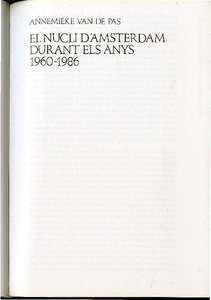Mostrar el registro sencillo del ítem
El nucli d'Amsterdam durant els anys 1960-1986
| dc.contributor.author | Van de Pas, Annemieke | |
| dc.date.accessioned | 2022-12-30T15:33:03Z | |
| dc.date.available | 2022-12-30T15:33:03Z | |
| dc.date.issued | 1988 | |
| dc.identifier.issn | 2385-362X | |
| dc.identifier.issn | 0212-3819 | |
| dc.identifier.uri | http://hdl.handle.net/20.500.11904/1326 | |
| dc.description.abstract | <p>That text is about the situation in Amsterdam from the sixties till nowadays, .emphasizing an essential point: the critic and constructive attitude of the artist towards society and the artistic world. The sixties stand out by a socio-political awareness as a fundamental part of the artistic process; the seventies marked the effervescence of the initiatives taken by the artists and, finally, the eighties distinguish themselves by the opening of many centres of art created by the artists.</p> <p>In 1962 the first Happening took place. Later on many experiences on performances would appear in the way of direct actions in public places which would mean a provocation as a result of having been chosen as locations far artistic actions. Besides the performances made in Amsterdam by such foreign artists as Nam June Paik, Gilbert & George, etc., and the experiences on feminist art as the subject of the performance made by Gina Pane, Ulrike Rosenbach, etc. two names, Marina Abramovic and Ulay, working together, are the most important representatives of present-day performances; and a space, De Appel, is one of the most important locations, not only by its productions and performances but also by the theoretical reflections on that subject published in a magazine named after it.</p> | |
| dc.relation.ispartof | Estudis escènics: quaderns de l'Institut del Teatre. 1988, Núm. 29 | |
| dc.title | El nucli d'Amsterdam durant els anys 1960-1986 | |
| dc.type | Article | |
| dc.date.updated | 2022-12-30T15:33:04Z | |
| dc.rights.access | Open Access |
Ficheros en el ítem
Este ítem aparece en la(s) siguiente(s) colección(ones)
-
1988: Núm.: 29 [15]


